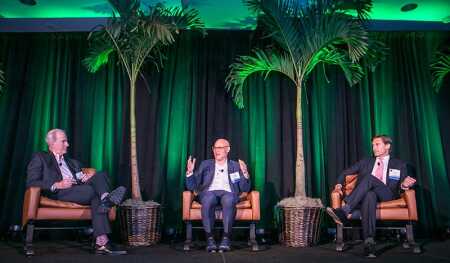Perhaps it is no coincidence that both Craig Robins, president and chief executive officer of real estate development company Dacra, and Kieran Bowers, president of Swire Properties, were schooled in the humanities before becoming real estate developers.
Bowers earned a degree in oriental studies with a concentration in Japanese from Pembroke College at Oxford University, while Robins, himself the son of a real estate developer, studied art as an undergraduate before attending law school.
“I wanted to become an art dealer, but it would have been impractical [as a career],” Robins said at the ULI Miami Investor Symposium in late October in Miami. Instead, he settled on becoming a developer, but one whose work shows a passion for art and design.
Robins’s approach to development is to see an individual property as a part of a whole, asking himself, “How can I make the neighborhood [rather than just one building] more valuable?” he said.
Robins began his career in South Beach in the late 1980s under the mentorship of Tony Goldman, a pioneer in what had been a run-down section of Miami Beach replete with aging art deco buildings from the 1930s and 1940s. Subsequently, his own firm, Dacra, played a significant part in restoring the Miami Art Deco District and developed new commercial projects.
“I started with historic restoration in South Beach, and [that emphasis] has been carried forward,” Robins said. “I like to create value by integrating art and culture with real estate to create a powerful sense of place, [like an] outdoor museum.”
Almost 20 years ago, Robins left South Beach and set his sights on redeveloping the 18-square-block area known as the Miami Design District. That area also had seen better days. When he first went there, “people thought I was out of my mind,” he said. However, the area has been transformed into a chic shopping district known for beautiful, architecturally significant buildings, as well as art galleries and fine dining.
Robins owns 70 percent of the Design District’s property and still has 2 million square feet (186,000 sq m) of development rights, he said. Among his current goals for the area is to add restaurants.
Working in the Design District seems to have given Robins free rein to let his imagination run wild. The Museum Garage in Miami’s Design District, which opened last spring, is an actual parking garage.
To develop it, Robins hired six artists and architects with widely different styles and color preferences to create a facade hiding the fact the building is a parking structure. Among the disparate pieces of art on the building are red, white, and blue jigsaw puzzle pieces; faux silver and gold cars; and a picture of a hand reaching for a bowling ball in a bowl of water.
In 2005, Robins launched Design Miami, a design fair that takes place each December at the same time as Art Basel Miami Beach.
For Bowers, head of U.S. operations for Hong Kong–based Swire, the company’s most ambitious project in Miami to date is Brickell City Centre, a 4.9 million-square-foot (455,000 sq m) mixed-use project on which the first phase of construction was completed in 2016.
Located in Miami’s Brickell neighborhood, the $1.05 billion development has become a Miami landmark. It sits on three city blocks and includes a five-star hotel, EAST, Miami; two class A office towers; two luxury residential towers; and a 500,000-square-foot (46,500 sq m) retail center. Phase two of the project, if approved, will have 972 residential units in two towers and nearly 90,000 square feet (8,400 sq m) of commercial space, among other features.
Bowers noted a distinguishing feature of the nine-acre (3.6 ha) Brickell City Centre project—its climate ribbon, a glass, steel, and fabric structure that covers the shopping concourse, letting in light and air and collecting rainwater used to irrigate the indoor landscaping.
Bowers likened Brickell City Centre’s vibrancy to that of South Street Seaport in New York City and compared the retailers to those on New York’s Fifth Avenue. For his part, Robins also likened the Design District’s retailers to those on Fifth Avenue and said the high fashion available in the district fits in naturally with the emphasis on art and architecture.
Asked who his primary customers are, Bowers answered, “wealthy young couples who enjoy an urban environment. They may be tourists or those who have a pied-à-terre in Miami.” Robins said his customers are either tourists or part-time Miami residents.
Robins and Bowers agreed that the emphasis on culture and creativity that has developed over the past 20 years or so in Miami is good for business. In particular, Art Basel Miami Beach, now in its 17 year, has had a huge economic impact on the city, Robins said. Early December in Miami used to be dead, but with the arrival of Art Basel in the first week of the month, “it gives Miami a second Christmas,” he said.





